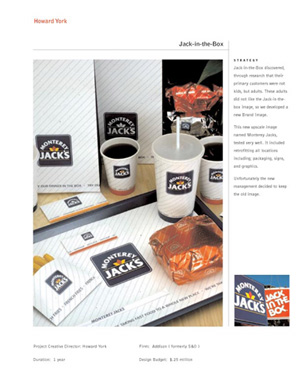My favorite Jack in the Box commercial is the one where a focus group is testing the new Ultimate Cheeseburgers. Someone in the group says “I don’t think it needs the buns,” which prompts Jack to bust into the room exclaiming, “Without the buns, your hands would be filled with meat and cheese!!” The group contemplates a second, and replies “So?” which prompts Jack to consign, “Ok, we’ll work on it.”
It’s a commercial that brazenly mocks consumers’ idiotic preferences, while at the same time, acknowledges the validity and power of focus group testing. The public knows what they like, want, accept, and will pay for — and they will readily tell anyone who asks.
Focus group research is an industry built on the promise of certainty. It’s a tool used by everyone: politicians, movie makers, usability developers, business analysts, and last but not least, the design industry. It’s prevalent in product design, branding, packaging, web interface, publications, and almost every other aspect of design and marketing you can think of.
Ideally, focus groups bring together individual groups of consumers/users, and solicits opinions, requirements, preferences, and trends — all to benefit the development of the host product or service. But in practice, the results are less than ideal.
There are generally two types of focus-group-finding categories — quantitative and qualitative. Quantitative is essentially a poll that yields comparative, measureable results of certain objectives. But keep in mind that while measurements are finite, interpretations of measurements are not. Qualitative is more about acquiring knowledge about the range of preferences, the effectiveness of messaging, the degree of acceptance, and a variety of other types of findings.
I’m currently in the middle of a large packaging redesign project for a large technology company. We have gone through major rounds of design focus groups, and are preparing for the next wave. The process has been valuable, as well as infuriating at times. The findings and results have been valuable to our agency and the client, but I can’t help but question their value to the end result.
The general concensus of most people who are veterans of focus group research is that they work, but not all of the time. They’re valuable, except when they’re really not. They can be accurate, but the degree of accuracy can be misleading in the end. And they’re helpful in product development, except when they’re not.
What has been your experience of focus groups? Have you personally participated in one? Do you find value or skepticism in them? Do they work? Or are they the tool of mediocrity and the bane of our profession. Please share.
Lastly, do cheeseburgers need buns after all?







Hmmm...it seems that few of you have had actual focus group experience — but surely you have an opinion on consumer preferences?
Haven't you ever been accosted by a clipboard-carrying pollster at the mall? Or been lured to attend a usability focus group after work?
On Oct.13.2004 at 04:14 PM